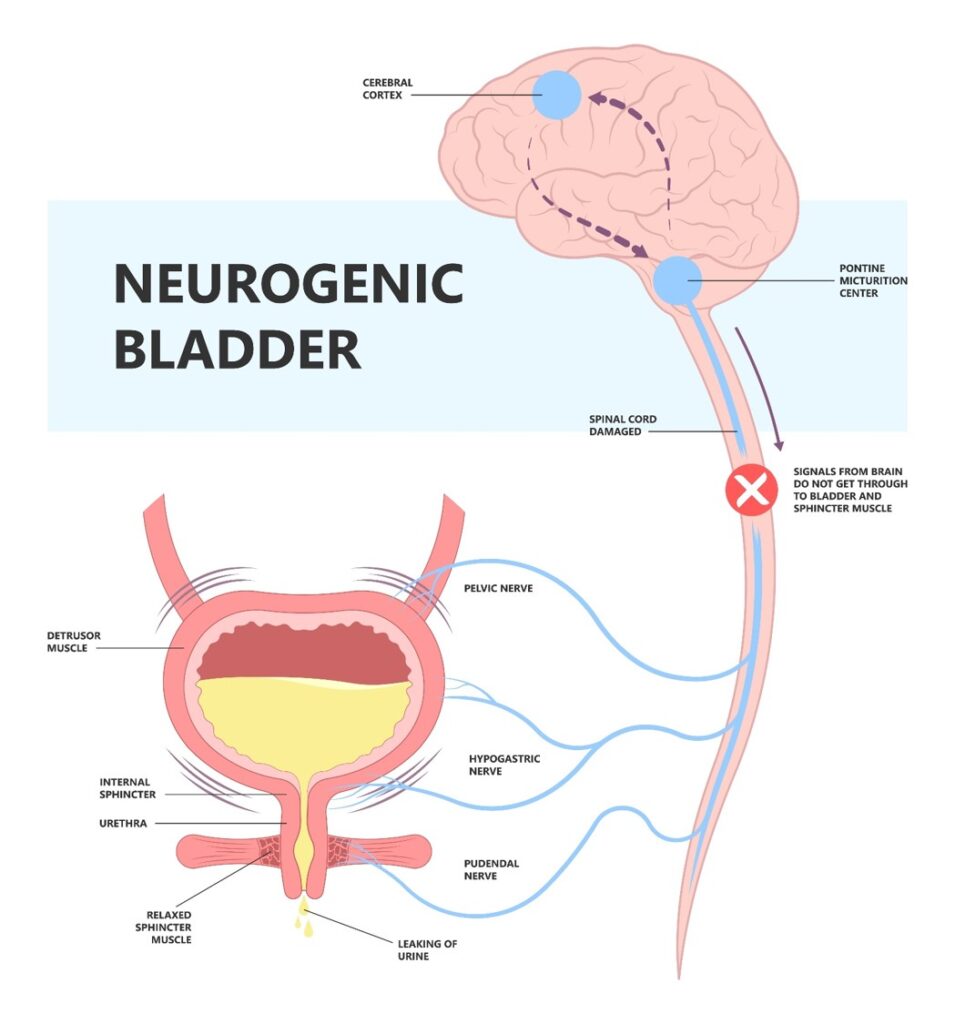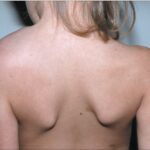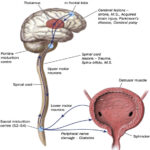Neurogenic bladder is a medical condition resulting from nerve damage that disrupts bladder function, leading to urinary retention, incontinence, and frequent infections. The condition can arise from spinal cord injuries, neurological disorders, diabetes, or congenital anomalies. Effective management requires a combination of medications, catheterization, surgery, and lifestyle modifications. This article explores the causes, symptoms, diagnostic techniques, and available treatment options for neurogenic bladder.

Understanding
1. How the Bladder Works
The bladder is controlled by a complex network of nerves that coordinate urine storage and elimination. Key components include:
- Detrusor muscle: Contracts to expel urine.
- Internal and external sphincters: Regulate urine flow.
- Spinal cord and brain pathways: Control voluntary and involuntary bladder function.
Disruptions in these neural pathways cause bladder dysfunction, leading to neurogenic bladder.
Causes
Neurogenic bladder can result from trauma, neurological diseases, or birth defects. The primary causes include:
1. Spinal Cord Injuries (SCI)
- Paraplegia and quadriplegia often lead to bladder dysfunction.
- Incomplete spinal cord injuries may cause partial bladder control issues.
2. Neurological Disorders
- Multiple sclerosis (MS): Demyelination affects nerve signaling.
- Parkinson’s disease: Loss of dopamine disrupts bladder coordination.
- Stroke: Damages brain regions controlling bladder function.
3. Diabetes Mellitus
- Diabetic neuropathy impairs nerve function, leading to poor bladder emptying and increased infection risk.
4. Congenital Conditions
- Spina bifida: Nerve malformations at birth cause bladder dysfunction.
- Cerebral palsy: Neuromuscular impairments affect bladder control.
5. Other Causes
- Pelvic surgeries or radiation therapy damaging pelvic nerves.
- Tumors compressing spinal nerves.
Types of Neurogenic Bladder
Neurogenic bladder is classified based on detrusor muscle activity and sphincter function.
1. Overactive (Spastic) Neurogenic Bladder
- Caused by upper motor neuron lesions (e.g., stroke, SCI above T12).
- Symptoms: Frequent urination, urgency, incontinence.
2. Underactive (Flaccid) Neurogenic Bladder
- Caused by lower motor neuron damage (e.g., peripheral neuropathy, diabetes).
- Symptoms: Urinary retention, incomplete emptying, recurrent UTIs.
3. Mixed Neurogenic Bladder
- Combination of overactive and underactive bladder dysfunction.
Symptoms of Neurogenic Bladder
Symptoms vary based on the type and severity of nerve damage but commonly include:
✅ Urinary incontinence or leakage
✅ Urinary urgency and frequency
✅ Difficulty initiating urination
✅ Weak or interrupted urine stream
✅ Frequent urinary tract infections (UTIs)
✅ Bladder distention and discomfort
Diagnosis of Neurogenic Bladder
1. Medical History and Physical Examination
- Assessing underlying neurological conditions.
- Evaluating urinary habits and symptoms.
2. Urodynamic Studies
- Cystometry: Measures bladder pressure and capacity.
- Electromyography (EMG): Evaluates nerve signals to bladder muscles.
3. Imaging Tests
- Ultrasound: Detects residual urine and bladder abnormalities.
- MRI/CT scan: Identifies spinal cord or brain lesions.
4. Urine and Blood Tests
- Urinalysis: Detects infections and kidney function markers.
- Blood tests: Evaluates kidney function in chronic cases.
Treatment Options for Neurogenic Bladder
1. Medications
- Anticholinergics (Oxybutynin, Tolterodine): Reduce bladder spasms.
- Beta-3 adrenergic agonists (Mirabegron): Improve bladder relaxation.
- Alpha-blockers (Tamsulosin): Help with urine flow in retention cases.
2. Catheterization
- Intermittent catheterization: Preferred for patients with retention.
- Indwelling catheters: Used for severe cases but carry infection risks.
3. Surgical Interventions
- Bladder augmentation (enterocystoplasty): Expands bladder capacity.
- Urinary diversion (urostomy): Reroutes urine flow for severe dysfunction.
- Sphincterotomy: Relieves bladder outlet obstruction.
4. Nerve Stimulation Therapy
- Sacral neuromodulation: Uses electrical impulses to improve bladder control.
- Posterior tibial nerve stimulation (PTNS): Non-invasive nerve modulation therapy.
5. Behavioral and Lifestyle Modifications
- Scheduled voiding: Helps train the bladder.
- Pelvic floor exercises (Kegel exercises): Strengthen sphincter control.
- Dietary changes: Avoid caffeine and alcohol to prevent overactivity.
Complications of Untreated Neurogenic Bladder
Without proper management, neurogenic bladder can lead to severe complications:
❌ Recurrent urinary tract infections (UTIs)
❌ Kidney damage and hydronephrosis
❌ Bladder stones due to urine stagnation
❌ Autonomic dysreflexia (a life-threatening rise in blood pressure in SCI patients)
Prognosis and Long-Term Management
- Lifelong monitoring is required to prevent complications.
- Patients with neurological disorders need multidisciplinary care.
- Early intervention with medications, catheterization, or surgery improves quality of life.
Neurogenic bladder is a serious condition affecting urinary function due to nerve damage. Early diagnosis and a tailored treatment plan, including medications, catheters, surgery, and lifestyle changes, can prevent complications and improve patient outcomes. Ongoing research into nerve regeneration and neurostimulation therapies offers new hope for patients suffering from this condition.

